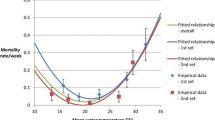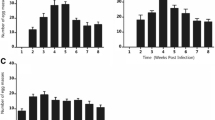Abstract
The direct and delayed effect of short-term exposure to low temperature (17.5 °C) on growth, reproduction and longevity of adolescent and mature freshwater Indoplanorbis exustus Deshyaes (Mollusca: Gastropoda) was studied in the laboratory. We found that growth and reproduction were retarded, but were enhanced when later they were returned to ambient temperature.
Similar content being viewed by others
References
Andrewartha, H. G. & L. C. Birch, 1954. The distribution and abundance of animals, Chicago Univ Press, 782 pp.
Boray, J. C., 1969. Experimental fascioliasis in Australia. In: B Dawes, (ed.). Advances in Parasitology. Academic Press, London, 210 pp.
El Hassan, A. A., 1974. Laboratory studies on the direct effect of temperature on Bulinus truncatus and Biomphalaria alexandrina the snail intermediate hosts of schistosomes in Egypt. Folia Parasit. 21: 181–187.
Goldstein, A., 1964. Biostatistics. The Macmillan Co., New York, 272 pp.
Harris, R. S. & W. A. G. Charleston, 1977. Some temperature responses of Lymnaea tomentosa and L. columella (Mollusca: Gastropoda) and their eggs. N.Z.J. Zool 4: 45–49.
Howe, E. W., 1953. The rapid determination of intrinsic rate of increase of an insect population. Ann. appl. Biol. 40: 134–151.
Kendall, S. B., 1953. The life history of Lymnaea truncatula under laboratory conditions. J. Helminth. 27: 17–28.
Malek, E. A. & T. C. Cheng, 1974. Medical and Economic Malacology, Academic Press, New York and London, 398 pp.
Parashar, B. D., A. Kumar & K. M. Rao, 1983. Effect of temperature on embryonic development and reproduction of the freshwater snail Lymnaea luteola (Gastropoda), a vector of schistosomiasis. Hydrobiologia, 102: 45–49.
Parashar, B. D. & K. M. Rao, 1985. Effect of temperature on growth, reproduction and survival of freshwater snail Indoplanorbis exustus (Gastropoda: Pulmonata), vector of schistosomiasis. Arch. Hydrobiol. 102: 379–386.
Rockstein, M., 1964. The physiology of Insecta., Vol. 1. Academic Press, New York and London, 640 pp.
Sturrock, R. F., 1986. The influence of temperature on the biology of Biomphalaria pfeifferi (Krauss), an intermediate host of Schistosoma mansoni. Ann. trop. Med. Parasit. 60: 100–105.
Sturrock, R. F. & B. M. Sturrock, 1972. The influence of temperature on the biology of Biomphalaria glabrata, intermediate host of Schistosoma mansoni on St. Lucia, West Indies. Ann. trop. Med. Parasit. 66: 385–390.
Vander Schalie, H. & E. G. Berry, 1973. The effect of temperature on growth and reproduction of aquatic snails. Sterkiana, 50: 1–92.
Author information
Authors and Affiliations
Rights and permissions
About this article
Cite this article
Parashar, B.D., Rao, K.M. Direct and delayed effects of low temperature on the freshwater snail Indoplanorbis exustus (Deshayes, 1934), intermediate host of schistosomias. Hydrobiologia 209, 259–264 (1991). https://doi.org/10.1007/BF00015348
Received:
Revised:
Accepted:
Issue Date:
DOI: https://doi.org/10.1007/BF00015348




